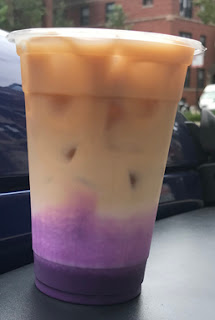Photo source: Mavens Creamery
Just a decade ago, U.S. dairy foods innovators would have never thought about using Asian flavors in everything from milk beverages to ice cream to yogurt. Well, from all the reports and conversations I’ve been having, the time is now for Asian flavors to be in the mainstream dairy department, from coast to coast.
Remember, what’s starts in foodservice eventually makes it to retail. And in case you have not noticed, Asian flavors have been on the rise across all food and beverage categories, in all types of foodservice, from fine dining to independent cafes. Many start out on TikTok and get transformed into trendy menu items. How about commercializing some of these concepts and bringing them to retail?
Pastry Sous Chef Jane Bayle of Utah-based hospitality group Leave Room For Dessert Eateries, says this. “Asia has such a wide variety of fruit-flavored ice cream. I’d love to see that in the U.S! Ice cream can be a learning moment for kids, helping to teach about fruit varieties and expanding palates. By incorporating a fruit puree in ice cream, you’re also able to sneak in tons of vitamins and nutrients, while minimizing the amount of sugar used in the overall recipe.”
She believes we will be seeing a lot more ube and red bean everywhere.
“Every time I introduce ube to someone, they end up loving it. Not only is the purple color very appealing, but the earthy, sweet aroma of ube is an excellent flavor to incorporate in pastries and ice creams. I also love red bean, though the name can make it a bit intimidating. Red bean is great because it’s packed with protein and is a little less sweet, so it works well in both sweet and savory recipes.”
Think red bean yogurt dip. And how about this awesome ube latte I had a few weeks ago at Wake ‘n Bacon in Chicago?
Ube is a purple yam originally from the Philippines. It has a vibrant purple color that is Instagram friendly, along with a sweet, slightly nutty, vanilla taste that goes perfectly with milk and coconut. In Filipino cuisine, it is often boiled and then mashed (skin and all) with sweetened condensed milk. In the U.S., it is showing up in ice cream and milky beverages.
Let’s not forget Vietnamese coffee. It’s made with a coffee press, Vietnamese coffee beans (usually robusta), condensed milk and boiling water. The pressed bean process produces a beverage with a very high caffeine content. Think energy drink, especially if coupled with the protein and sugar of the condensed milk.
Ice cream, as well as coffee- and tea-milk drinks are probably one of the best places for U.S. processors to start experimenting with Asian flavors and ingredients. Other flavors to consider include black sesame, chai, matcha green tea and taro.
Bubble tea does not need to be limited to a beverage. Those chewy tapioca pearls can be used in yogurt, dairy desserts and ice cream.
Then there’s durian, one of the most banned fruits from hotels—yes, you will be fined if you bring the fruit into a room in Asia—yet still widely popular throughout Asia. The oblong, spiky fruit has a pungent smell that is somewhere between gasoline and rotten eggs. The fruit, however, has a custard-like texture that pairs well with dairy…if you can handle the aroma.
Less than a year ago, select Costco stores in the San Francisco Bay Area began selling pints of Maven’s Durian Ice Cream.
“I must say that ice cream, because it’s already blended with cream, sugar, milk, the taste is toned down. In terms of how strong it smells, how pungent, it’s maybe a five or six out of 10. But the fresh fruit when opened—that’s 20,” said Christine Nguyen, co-owner of Maven Creamery, with her sister Gwen. She was quoted a year ago in the SFGate. You can read the article
HERE.
“We’re very proud of this durian ice cream because if you look at the rest of the ingredients, it’s very, very simple: milk, sugar, cream and durian,” she told the SFGate.
“There are just certain ingredients that are introduced being Vietnamese,” Gwen told the SFGate. “Fish sauce, that’s in our DNA. So durian fruit, I just have always known for it to be a part of a dessert or a fruit after we would have a meal. It is a delicacy fruit, though, and it’s very rich, so you probably wouldn’t want to have it every day.”
CNBC reported on September 13, 2023, that “Global demand for durians has soared 400% year-on-year, largely bolstered by a ‘craze’ for the fruit in China. Over the past two years, China imported $6 billion worth of durians, which accounts for 91% of the global demand.”
Another unique Asian flavor profile comes from Bird’s nest, which is the nest of swiftlets, a type of bird that uses solidified saliva to make its nest. Those nests are harvested and consumed by humans as a delicacy with health benefits, something along the lines of a fountain of youth.
Vinamilk in South Korea markets milk with Bird’s nest. Labels claim it contains vitamin K2, which helps to increase the potential of calcium binding to the bones, supporting the skeletal system. It also supports the immune system with vitamins A, D3 and selenium.
It’s time to start innovating with these Asian flavors. Let’s be a leader not a copycat.






No comments:
Post a Comment